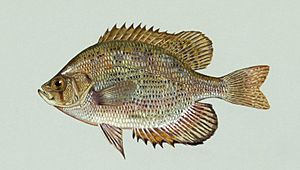Flier (fish) facts for kids
Quick facts for kids Flier |
|
|---|---|
 |
|
| Conservation status | |
| Scientific classification | |
| Synonyms | |
|
Labrus macropterus Lacepède, 1801 |
The flier (Centrarchus macropterus) is a cool type of freshwater fish. It's part of the sunfish family, called Centrarchidae. You can only find fliers in the southern parts of the United States. This fish is so special that it's the only species in its group, called Centrarchus. During World War II, a United States Navy submarine was even named the USS Flier after this fish!
Contents
About the Flier Fish
The flier is a small fish with a body that looks a bit squished from the sides. It has a mouth that points slightly upwards. Its top fin, called the dorsal fin, has 11 to 13 sharp spines and 12 to 14 soft rays. The fin underneath, called the anal fin, has 7 to 8 spines and 13 to 15 soft rays.
Fliers have a special line along their side, called a lateral line, which helps them feel vibrations in the water. Their scales are rough, like tiny combs. Their bodies are covered in dark spots, their bellies are light, and their backs are olive green.
You'll notice a dark line going through their eye, which continues down like a "teardrop." Younger fliers, less than about 45 millimeters (1.8 inches) long, have a clear dark spot on the soft part of their dorsal fin. This spot looks like an eye and has a reddish edge. The fins on their sides and underneath are dark with lighter patterns. The biggest flier ever found was about 29.2 centimeters (11.5 inches) long. But usually, they are around 13 centimeters (5.1 inches) long. The heaviest flier recorded weighed about 1.35 pounds.
Where Fliers Live
Fliers live in the southern United States. You can find them along the Atlantic coast, from the Potomac River in Maryland all the way down to central Florida. They also live in rivers that flow into the Gulf of Mexico, as far west as the Trinity River in Texas. From there, they swim north into the Mississippi River system, reaching southern Illinois and southern Indiana.
Flier Fish Homes and Habits
Fliers like to live in clear, slightly acidic water. They prefer places like swamp ponds, slow-moving creeks, and calm parts of rivers called oxbows. These spots usually have lots of plants growing in the water. The water temperature they like best is usually between 23 to 29 degrees Celsius (73 to 84 degrees Fahrenheit).
Fliers mostly eat small creatures without backbones, like insects, snails, worms, and leeches. But they will also eat smaller fish and tiny water plants called phytoplankton.
Reproduction and Life Cycle
Fliers usually start breeding from March to May, when the water gets warmer, around 14 to 17 degrees Celsius (57 to 63 degrees Fahrenheit). Sometimes, they might even start as early as February. Female fliers ready to lay eggs have been found in many different places. These include ditches filled with debris and soft bottoms, or streams with gravel bottoms and lots of plants.
Fliers can lay their eggs in various water conditions. This includes clear, flowing water, cloudy water, or even still water in ditches and pools. They build their nests in rocks or gravel. Their eggs are sticky and are surrounded by a round, sticky layer. Fliers are social nesters, meaning many of them build their nests close together in groups.
Fliers become old enough to have babies when they are about one year old and around 70 millimeters (2.8 inches) long. The male flier takes care of the eggs and the newly hatched baby fish. If fliers get scared, they quickly hide among water plants, under tree roots in the water, or in floating mats of plants.
Naming the Flier Fish
The flier fish was first officially described by a French expert named Bernard Germain de Lacépède in 1801. He called it Labrus macropterus. Later, in 1829, another scientist named Georges Cuvier put it into its own group, or genus, called Centrarchus.
The name Centrarchus comes from two Greek words: kentron, meaning "sting," and archos, meaning "anus." This name refers to the long spine on the fish's anal fin. The second part of its scientific name, macropterus, is also Greek and means "long fin."


